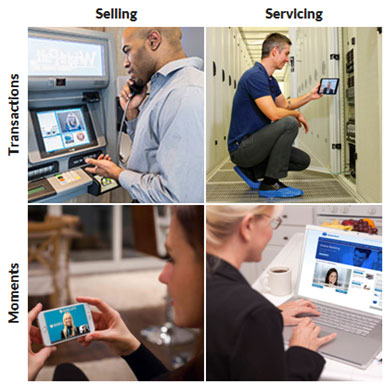In our previous post, we discussed the evolving role of video for customer interactions. Let’s explore how Customer Experience leaders are leveraging video.
Customer service is becoming transactional. Let’s explore how Customer Experience leaders are leveraging video.
A few years ago, the Corporate Executive Board released its research on customer loyalty. Published under the provocative title “Stop Trying to Delight Your Customers”1, it showed that, when it comes to customer service, customers want first and foremost their inquiries or problems to be resolved quickly and easily. It transformed the Customer Experience discipline, introducing the “effortless” imperative. Time became the currency for both buying products and getting service. This consumer expectation met enterprises’ desire for reducing service costs in a perfect storm. Many interactions were turned into transactions, often thanks to self-service. Late 2014, Forrester noted that web self-service had become the most widely used communication channel for customer service, ahead of the agent-assisted voice channel.
Not so fast!
If self-service brings convenience and speed, it is not the panacea. Indeed, we all have experienced situations where we have a question, cannot find an important piece of information, or simply need confirmation from a person. Good self-service includes the option of getting live assistance. Gartner predicted that by 2017, one-third of all customer service interactions will still require the support of a human intermediary.
Capturing moments
Not all customer interactions should become transactions fulfilled using self-service. Some require advice and a discussion with a knowledgeable person. Furthermore, enterprises are finding it important to maintain an in-person relationship with their customers. Enterprises need to identify the important moments of their customers’ journeys and turn them into quality interactions with an associate. Google research shows that being present and engaging at the critical moments of consumer journeys has become critical2 in our digital world.
Transactions and moments
The role of video is best comprehended in the context of what consumers are trying to do. When looking to get things done, time is the currency. Consumers prefer self-service but when they need assistance, seeing and dealing with a person is the best way to handle impatience. In the context of a journey, the role of video is to maximize pivotal moments, enabling a quality conversation with a knowledgeable person. Compounded with the service and sales scenarios, we get the four main use cases for embedded video communication.

- Self-service assistance – Video brings concierge services for sales transactions. In addition to providing advice, seeing a person changes the interaction by enabling trust, emotion, and engagement. This is what Mumbai-based IndusInd bank provides to its mobile clients.
- Visual troubleshooting – For support, a picture is worth a thousand words. Netherlands-based Dekra has harnessed video for insurance claims. Adjusters use video to assess small damages with customers remotely, settling cases in days instead of weeks.
- Consultative selling – Video makes associates available to help with research or selection. Springfield-based BluCurrent has deployed video in its branches for opening accounts and other non-teller duties, garnering a 4.5 satisfaction rating on a scale of 5.
- Expert access – Video is eventually an enabler of customer success. It removes time and distance barriers to expert access. London-based Barclays has rolled out a 24-7 on-demand video service to its Premier customers to help them with mortgages or investment decisions.
High-value interactions and high-value customers
These different use cases have in common the ability to seize the moment to either provide great service to high-value customers or to maximize high-value interactions. They find their economic justifications differently though:
- Self-service assistance finds its return on investment in improved conversion of prospective buyers and higher order value. IndusInd Bank serves more than 1,000 clients daily.
- Visual troubleshooting translates into higher First Call Resolution (FCR) and reduced Average Handling Time (AHT). Dekra adjusters have been able to increase the number of daily assessments from 6.5 to 11.
- Consultative selling improves customer acquisition and increases wallet share. BluCurrent saw a 20% increase in product upsell after it implemented video banking.
- Expert access improves Customer Satisfaction (CSat), reduces churn, and ultimately increases the Customer Lifetime Value (CLV). Barclays video service enjoys a doubled Net Promoter Score (NPS) over its legacy voice service
Looking at video use cases from the lenses of transactions and moments, when selling or servicing customers shed a new light on its business benefits. In our next blog post, we will look at what makes video a unique communication channel.